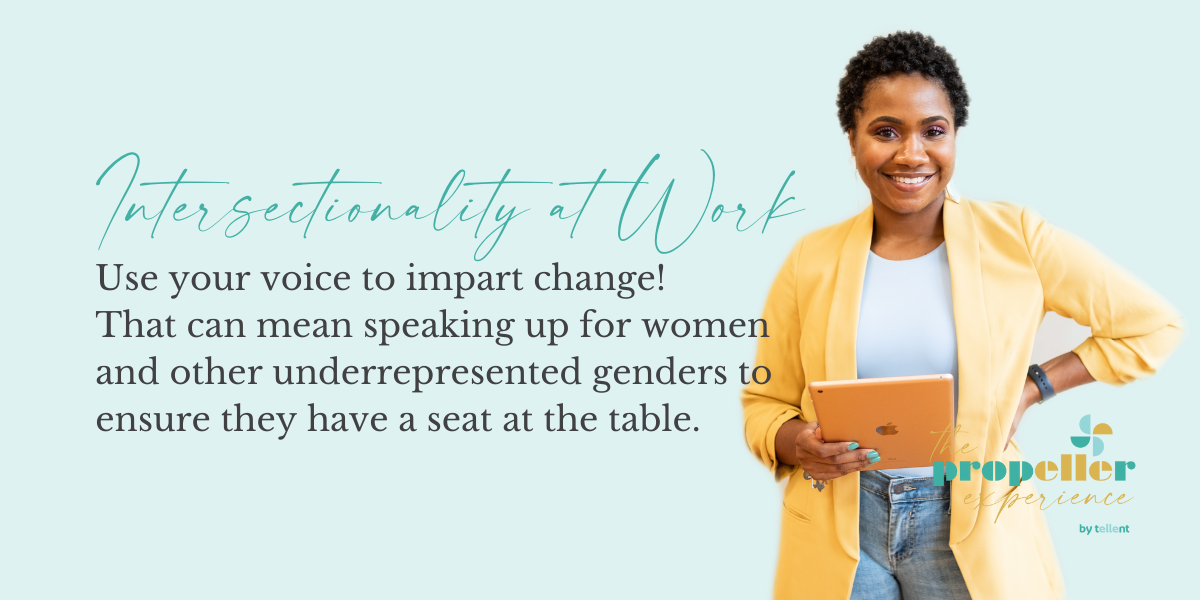While intersectionality is not a new concept, it has gained important traction and awareness in the past few years within the media and work culture. When it comes to intersectionality at work, it’s important to understand that it impacts all individuals and levels within an organization. The impacts of intersectionality as it relates to the world of work are undeniable - whether you’re a hiring manager, business leader, employee or shop owner.
The term “Intersectionality” was coined in 1989 by professor Kimberlé Crenshaw to describe how “race, class, gender, and other individual characteristics “intersect” and overlap with one another. As a diversity recruitment and social impact organization with a mission to close the opportunity equity gap, the world of work must always be examined through the lens of intersectionality in order to impart the types of changes that will lead to a more equitable and transparent world!

So, let’s take a deeper look at what Intersectionality is, what’s important to understand and how you can apply intersectionality within the broader context of your employment, organization, staffing and hiring strategy!
defining Intersectionality:
Intersectionality looks at the overlap between marginalized groups, and acknowledges that everyone has their own unique experiences of discriminiation and oppression that must be considered, such as: gender, race, class, age, sexual orientation, physical ability, etc.
intersectionality for women at work:
When looking to advance women in the workforce, it is vital to consider the interplay of intersectionality when we’re building structures and organizations that promote diversity, inclusion and equal opportunity.
“Woman” is not an all-encompassing bucket category that can define our respective relationships to power. A black woman may experience discrimination and racism, but she will experience discrimination differently from a white woman and racism differently from a black man. The progress towards closing the opportunity equity gap must always remain intersectional - “any feminism that purely represents the experiences of white, middle class, able-bodied, heterosexual etc. women will fail to achieve equality for all.”
actions to help you be a more intersectional ally in the workplace:
understand and evaluate your own privilege:
Privilege goes beyond skin colour to things such as middle class status, education level, physical ability, being cis-gender etc. All of your social identities play a part in constructing your access or “privilege,” whether you’ve asked for them or not. By first acknowledging your inherent privilege you can begin to recognize the types of opportunities that have been afforded to you and not afforded to others and take action steps towards a more inclusive workplace.
recognize intersectional overlap
We don’t want to overgeneralize or simplify the lived experiences of individuals by bypassing the intersectional nature of their experience in the workplace. Recognizing that people experience the world differently based on how their identities overlap is so important for leaders and decision makers as we put equitable systems in place to disassemble systems of oppression.
listen and learn from diverse groups:
Listening to people and their issues and coming from a place of curiosity helps us all to better understand people’s unique experiences. Ask questions to find out how you can support them and take the time to educate yourself on how to become a better ally. There are so many resources and courses that can help you put learning into action. It’s important to dedicate that time and commit yourself to life-long-learning!
create space for diverse groups
Use your voice to impart change! That can mean speaking up for women and other underrepresented genders to ensure they have a seat at the table. Here are few examples of how you can use your voice:
If you are speaking on a panel or joining a committee, make sure that the other speakers and members represent a diverse group of individuals - including members of the BIPOC, LGBTQ+ and differently-abled communities.
If you are creating support or programming related to a particular group of individuals, it’s so important to include their unique perspectives to ensure that multiple voices are represented.
Achieving complete intersectionality and equality will take work and dedication from individuals at all levels. We recommend making conscious and planned steps in order to become a more intersectional ally, as well as taking the time to educate peers, colleagues and leaders so there is accountability in moving the needle forward!
about tellent
Tellent bridges the talent gap in the new work economy and aims at increasing women’s economic contribution, progressing gender equity and preparing companies for evolving workforce trends in order to stay competitive in the future of work. The platform includes the Propeller Experience, an 8-week career accelerator program, a job board, and virtual networking platform.
about randstad canada
Randstad Canada is a leader in the HR services industry and specializes in flexible work solutions. As a trusted partner in the digital world of talent, we combine the expertise and passion of our people with the most innovative HR technologies to support talent and organizations in realizing their true potential.